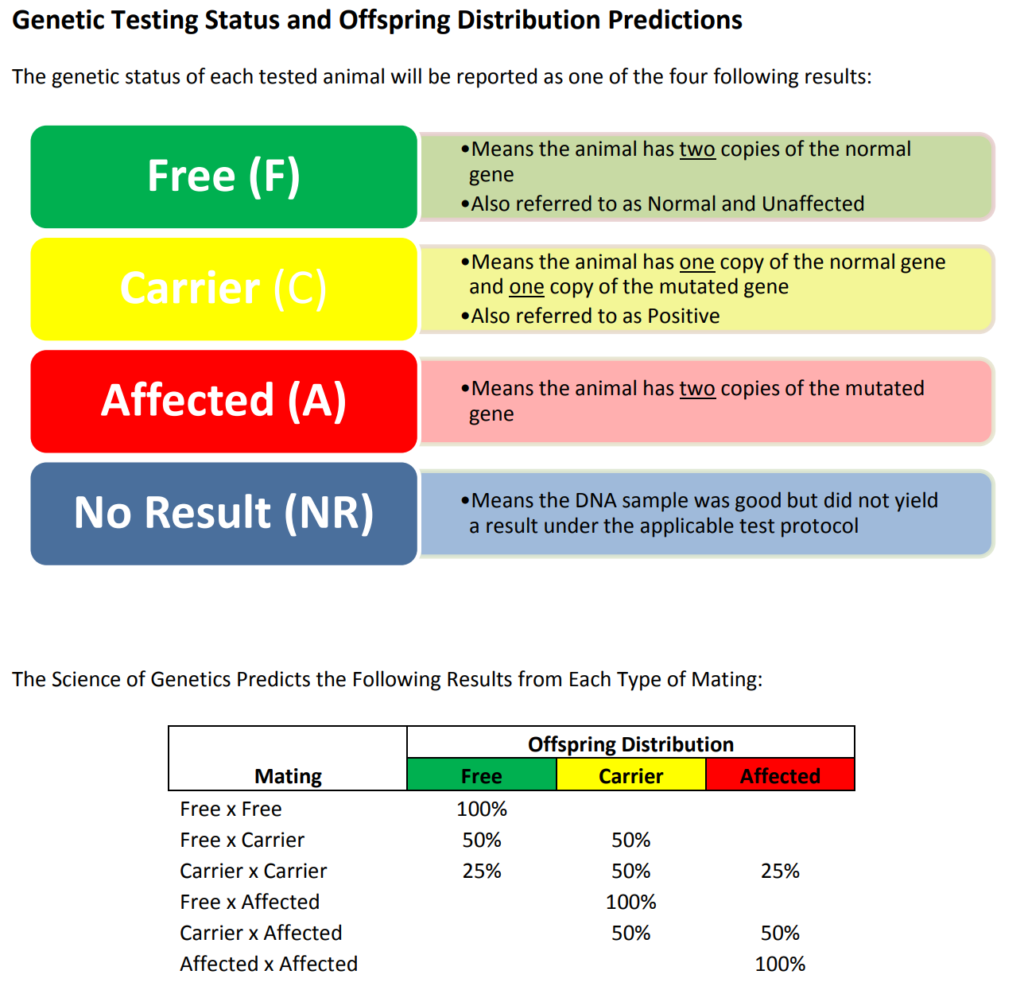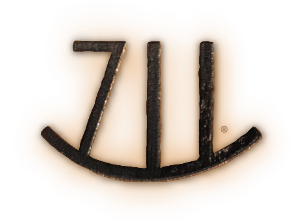What is a Recessive Trait?
Many physical traits can be linked directly to a specific genetic variant (mutation) in the DNA, and these variants can be passed from parent to offspring. Because an animal inherits a copy of DNA from each parent, a mutation can be transmitted from either the sire or the dam.
A “dominant” trait is one that is physically observable in an animal when it inherits only one copy from either its sire or dam. It only takes one copy of the mutation to change the physical appearance of that animal. An example of this is Black hair color.
A “recessive” trait is one that is only physically observable when a calf inherits a mutated copy of the DNA from both parents. An example of a recessive trait is red coat color. Note that not all recessive traits are bad or of an economical problem for the animal and some may in fact have a selective advantage. Two copies of the mutation are necessary to change the physical appearance of that animal. For this reason, an animal with only one copy of the recessive gene (a “Carrier” of the gene) will not show any sign of the trait. An animal with two copies of the recessive mutation (an “Affected” animal) will show the trait. Only a breeding of two Carrier parents or a Carrier and Affected parents can create an Affected animal.
Why have these Recessive Traits recently shown up in Wagyu cattle?
Most animals are actually Carriers somewhere in their DNA for one and often many recessive traits. Because an animal must inherit two copies of a given recessive gene to be Affected, and with only a few animals typically sharing the same recessive mutation in the whole population, there is rarely a mating cross that has the potential to create Affected offspring under natural selection. Most abnormal recessive traits are never even discovered.
However, under the selection pressure of most current animal breeding strategies, and given the relatively small founding population of Wagyu cattle outside of Japan, it is common to utilize a backcross and line breeding with a highly regarded sire line. If the original sire was a Carrier, there is a percentage of its generational offspring that will also be Carriers. In this case, it creates a higher-than-average frequency of Carriers and potentially Affected cattle in the population. Artificial insemination of a popular sire which is a Carrier of a recessive gene is capable of spreading this gene throughout a population much faster than when bulls are only used in natural breeding conditions. This has also happened in the Wagyu breed in Japan, Australia, and the United States.
What are the Five Known Genetic Recessive Disorders?
Several Genetic Recessive Disorders have been shown to be caused by recessive traits (mutations) in the Wagyu breed:
- Erythrocyte Membrane Protein Band III Deficiency (Spherocytosis) (“Band 3” or “B3) – Affected cattle (cattle with two copies of the causative mutation) are morbidly anemic. The mutations affect a protein necessary for proper shape and function of red blood cells. Calves are sometimes born weak and small (40-55 lbs birth weight) with severe anemia, labored breathing, palpitations, and not able to stand or suckle at birth. This disorder is often lethal, but some affected cattle survive to adulthood, although often with severely retarded growth.
- Claudin 16 Deficiency (“CL16”) – This mutation causes a buildup of fibrous tissue in the kidneys as well as other tissues. Affected cattle suffer from a severe risk of kidney failure throughout their lives. Other symptoms include growth retardation, increased blood urea nitrogen and creatinine values, diarrhea and overgrowth of hooves. It may or may not be lethal, but affected cattle tend to have atypically short lives.
- Chediak-Higashi Syndrome (“CHS”) – Affected cattle have a deficiency in cells that make up a functional immune system. As a result, these calves are often more susceptible to disease and infection. These cattle may also have a light coat color, and slight coagulation problems (hemorrhaging). This disorder is usually not lethal.
- Bovine Blood Coagulation Factor XIII Deficiency (“F13”) – This disorder is where one of the proteins needed to form blood clots is missing or reduced. Symptoms include severely prolonged bleeding time, bruising from castration/branding, and severe anemia. Death occurs in most cases.
- Factor XI Deficiency (“F11”) – This mutation affects the efficiency of the clotting factor F11. Affected cattle suffer from mild hemophilia-like bleeding tendencies, either spontaneously or following trauma and surgical procedures. It is also possible that Carrier x Carrier mating have increased difficulty producing viable fertilized embryos and full-term pregnancies and are sometimes “Repeat Breeders” (cows that loose their pregnancy soon after conception and are then rebred, causing abnormally longer periods between calving). It has been reported that factor 11 increased rebreeding by 50% in the Canadian Holstein breed.

Managing Recessive Genetic Disorders in Fullblood, Purebred, and Percentage U.S. Red and Black Wagyu Cattle
For proper herd management it is important for breeders to have an accurate understanding of the status of their cattle with respect to the genetic disorders. Without knowing the Free (no copy of the gene, or “F”), Carrier (one copy of the gene, or “C”), and/or Affected (two copies of the gene, or “A”) status of cattle in a breeder’s herd, it is impossible to eliminate or reduce the risk of propagating the disorders in future generations of cattle. Actively addressing these genetic disorders will pay dividends in the future to both the breeder and collectively for the Wagyu breed. Methods for managing recessive genetic disorders are breeder specific and depend on the type of cattle operation, i.e., registered, commercial, fullblood, purebred, percentage, seedstock, beef production, etc. Below are five example methods of management for breeders to consider. It should be noted that this list is not all inclusive.
- Test all animals and remove Affected animals from the herd. Always use Free animals to mate with any Carrier animals remaining in the herd. A commitment must be made to test all offspring from Carrier animals that will remain in the breeding herd. The Carrier rate will be reduced over time in future generations.
- Test all animals and remove all Affected animals and Carrier sires. Use only Free sires in the breeding program going forward. A commitment must be made to test all offspring from Carrier dams that will remain in the breeding herd. This will reduce the Carrier rate the same as the previously described method.
- Test and remove Carrier and Affected animals from the herd. Only use Free animals in the breeding program going forward. No further testing will be required. This method will ensure a totally Free herd going forward.
- Test all animals and use Carrier and/or Affected animals only in a terminal breeding program.
- Test all animals and use Carrier and/or Affected animals only as recipients. If a cleanup bull is used over the recipients, it should be Free. Offspring DNA verified to the cleanup bull must be tested for any animals that will remain in the breeding herd.
These are just five examples of management methods that can be used exclusively or in combination. As discussed above, proper management has a major impact on reducing the frequency of Carrier and Affected animals in a breeder’s herd. The most important management point is to ensure that that no Carrier or Affected bull is used in the breeding program, as bulls pass on their genetics to numerous offspring, and when a Carrier bull is bred to a Carrier female, there is a 50% probability of inheritance of the recessive disorder gene from the bull and a 50% probability of inheritance of the recessive disorder gene from the female, and therefore and a statistical 25% probability that the offspring will inherit copies of the recessive disorder gene from both parents and thus be Affected.
The “Bottom Line”
The “bottom line” on the matter of genetic recessive disorders is that if a producer is breeding for beef production (as opposed to seedstock production) using “Carrier” females will have absolutely no impact on the business so long as the producer uses “Carrier-free” bulls, so it makes financial sense to acquire lower priced “carrier” females to populate the cow herd. But if the producer is breeding to produce seedstock, the typically lower cost of the Carrier female is financially offset by the fact that offspring of the Carrier female that the 50% of offspring that inherit the recessive gene from the female (and are thus Carriers) will be less valuable. The advantage to buying Carrier female animals, for a beef producer, is that they are typically less expensive and there is no impact on the business so long as carrier-free bulls are used. The disadvantage to a seedstock producer of using Carrier female animals is that offspring must be tested (for which there is a cost) and 50% of offspring will be carriers and will typically be less valuable in the marketplace.
